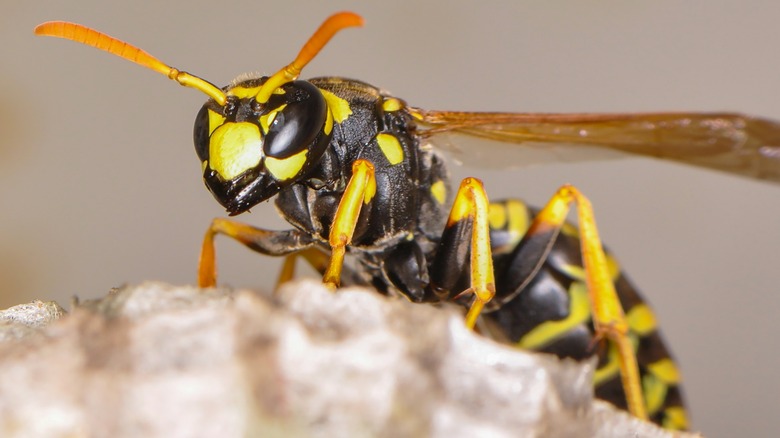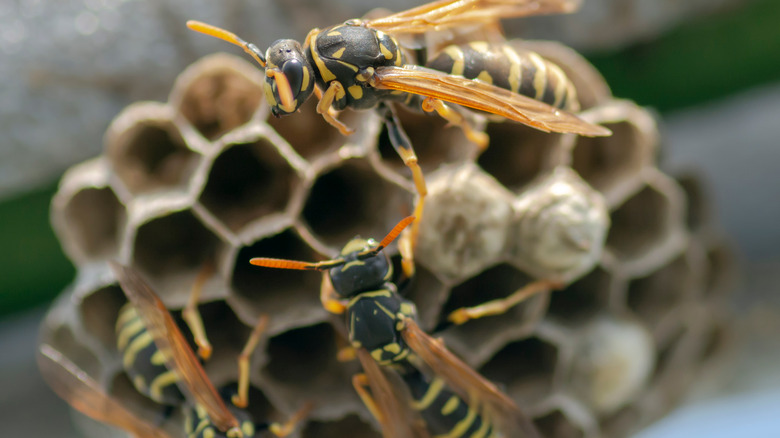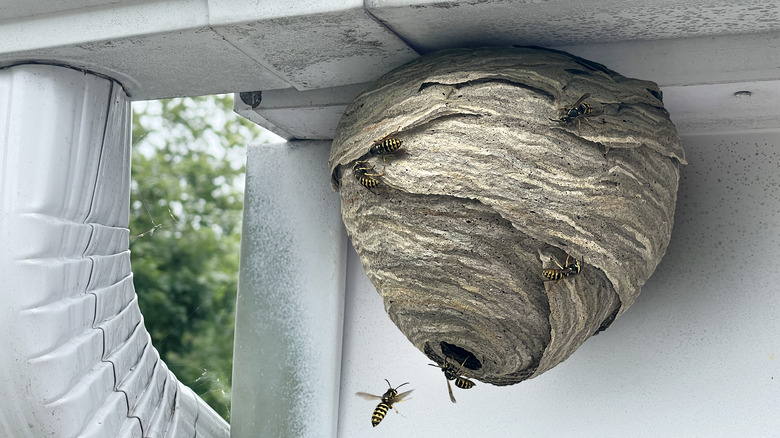The Bizarre Effect UV Rays Have On Some Wasps' Nests
Wasps, all too often, get a very bad rap — even though there's definitely a difference between bees, hornets, and wasps. Bees tend to be seen as fluffy, friendly pollinators, and it's certainly true that aggression doesn't always come naturally to them (plus, it wouldn't be good news for us if all the bees died). After all, per PBS News Hour, honeybees die after stinging people. Their powerful, spiky stingers cut into flesh so effectively that they cannot be removed afterwards without tearing the bee's abdomen. University of California apiculturist Eric Mussen told the outlet, "It's kind of like bleeding to death ... fake, clear insect blood."
Metro reports that male bumblebees have no sting. It is the workers (and the queen) that have stings, but theirs are smoother and can be retracted without damage to themselves. Regardless, bees generally only attack as a matter of self- or hive-protection.
Whether bee or wasp, whether they can repeatedly sting or not, there's one thing you definitely don't want to do: mess with a hive. They can have many, many angry occupants. PestLock states that up to 10,000 wasps can occupy a nest in summer.
How wasps build their nests
As the RSPB reports, the nest of a wasp is a unique and curious structure. It is crafted from paper, in a complex process that begins with the leader of the colony itself: the queen. During the spring, the queen begins the long process of building this essential structure, before its many eggs start to make an appearance. When this begins to happen, the laying of many, many eggs (another essential process to ensure the wasps' survival, naturally) takes precedence. Fortunately, all of these new workers that have been hatched from the eggs can then take over.
Per Pest UK, wasp nests are used by only one colony. The new queen, when the previous colony has died, will create their own from scratch, and so the cycle begins anew. They're relatively selective with the places they'll choose to do so, however. As the Natural History Museum in London, England, reports, wet areas will endanger the wasps, so those are out. A quiet hideaway, tucked in a corner or even below the ground, fits the bill nicely.
These paper nests are, the outlet goes on, crafted from wood, which the queen (and later her workers) chew. The process makes the material softer and manageable, ripe to be molded into the strangely beautiful shapes wasp nests take. Their design is practical, too, as the honeycomb-esque structure provides neat little chambers for laying eggs into. There doesn't seem to be any great mystery to these nests, but ultraviolet light can reveal something remarkable about them.
Why UV?
Via The Royal Society, the August 2021 study "Bright green fluorescence of Asian paper wasp nests," from Willy Daney de Marcillac et al, details a surprising discovery. The study reports that there are a lot of known examples of "natural fluorescence ... of marine organisms based on blue or ultraviolet light irradiation." Among the species that dwell on dry land, however, such naturally-occurring effects are far lesser known.
In a Vietnamese forest, the study describes, nests of paper wasps of the Polistes genus were discovered to have "inherent and strong greenish yellow fluorescence," which the scientists investigated using ultraviolet flashlights. A half-dozen species from different parts of the world (and their nests, of course) were studied, and this was where the strongest effect was found.
According to the scientists, this ethereal effect can be "attributed to fluorophores incorporated in the silk proteins of the cocoon caps fabricated by the larvae prior to their metamorphosis." Why would these wasps want fluorescent nests, though? The study suggests that the wasp's nests' fluorescence could act as a beacon during twilight, or possibly provide camouflage. Only some wasp species build nests, but the clever critters have good reasons for doing so.


